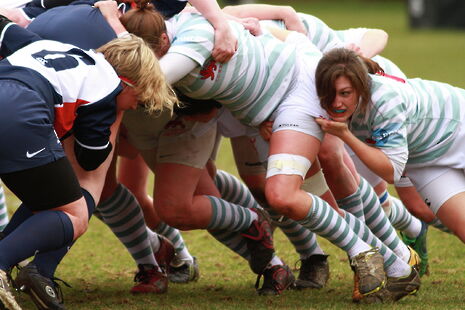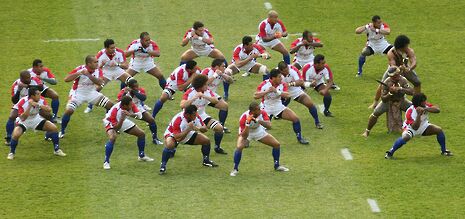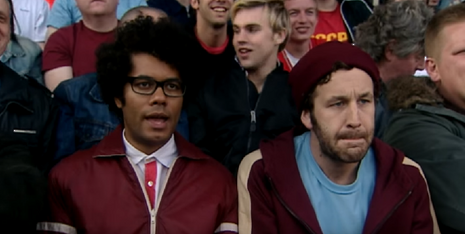Rugby for Dummies: a blagger’s guide to the Varsity matches
With the Varsity matches at Twickenham just around the corner, columnist Ben Cisneros presents his beginner’s guide to rugby union

Rugby union is set to take centre-stage in the consciousness of the Oxbridge sporting world, with the all-important Varsity matches at Twickenham just under a fortnight away.
Many of a Light Blue persuasion will be cheering on the Cambridge teams, but there are many technical rules, often geared towards protecting the safety of the players, that even referees tend to forget. Indeed, even the basics, for the untrained eye, can be hard to fathom. With this in mind, Varsity has produced a guide for those wanting to cheer on the Light Blues without looking lost.
Each team has 15 players. Their overall aim is to score more points than their opponents, through tries, conversions, penalties and drop-goals, over 80 minutes of play (two 40-minute halves). Each team has two sets of players: the forwards – numbered 1 to 8 (usually the big lads) – and the backs, numbered 9 to 15 (usually the more skillful players).
The main aim of the game is to score tries, worth five points. These are scored by touching the ball down over the other team’s try line. Tries can also be converted for an additional two points, by kicking the ball off a tee through the posts from in line with where the try was scored.
Teams can also score points from penalties that are awarded following an infringement, whether it be a technical offence (such as collapsing a scrum) or foul play (such as dangerous tackles). Typically, this will involve the specialist kicker kicking the ball off a tee through the posts to score three points. The final way of scoring points is from drop-goals, which are also worth three points. These can be scored at any time during the game.
Perhaps the most important rule in the whole game is that the ball must always be passed backwards. It can be kicked forward, but if the ball is dropped forward, or passed forward, the ball will be given to the other team to put into a scrum.
Scrums are the first of the two set-pieces, and the most difficult to understand. Indeed, while some props may claim to be experts in the field, even they seem fairly clueless, as a lot of penalties are awarded during the scrum for a multitude of vague or complicated offences. In essence, a scrum sees all the forwards pack down against their opposite numbers. The front rows of each team lock together and, once the scrum-half has rolled the ball into the middle, each side pushes. The hooker will try to hook the ball back with their foot quickly. The ball will then reach the feet of the number 8, who can release the ball from the scrum by themselves or via their scrum-half.
When the ball goes into touch, there will be a line-out. The ball can only be kicked into touch ‘on the full’ (without bouncing) from inside your own 22m line or from a penalty: otherwise the line-out will be from in-line with where the kick was made. The ball will be thrown into the line-out by the team who has not just kicked it out (except for penalties).The hooker will throw the ball in and another player (often a lock) will be lifted into the air to catch and secure the ball for their team. The ball must be thrown in straight.
While the ultimate aim of the game is to score tries, each team also has to defend their own try line. Any player who has the ball in their possession can be tackled. Tackles must be made below the neck and cannot lift the player beyond the line of horizontal.

Dangerous or high tackles will lead to a penalty and, if sufficiently serious, a yellow or even red card. A yellow card in rugby leads to a 10-minute stint in sin bin, while red cards see the player is sent off for the rest of the match. There is no injury time in rugby – the clock can be stopped by the referee throughout the game – so the match ends as soon as the ball goes out of play after 80 minutes have passed
Who's who? A guide to who plays where
There are the forwards (‘the Big Lads’) and the backs (‘the Skilful Ones’).
Prop
Plays in the front row of the scrum, where they provide stability and act as a conduit to their team’s pushing. They are generally a chunky and strong player who pushes their weight about.
Hooker
The hooker is in the middle of the front row at the scrum, and seek to ‘hook’ the ball back to their side. They also throw the ball into the line-out and tend to be a similar build to the props.
Locks
Locks are usually very tall players -who have the principal job of catching the ball in the line-out.
Flankers
As their name suggests, flankers find themselves on either side of the scrum. They are typically the most athletic of the forward pack: they will often be seen charging down kicks and trying to win the ball in rucks.
Number 8
Located at the back of the scrum, number 8s are usually one of the biggest and strongest players on the pitch. They are usually tasked with carrying the ball hard and making dents in defences.
Scrum-Half
Scrum-halves are normally one of the smaller players, who typically act as the link-man between forwards and backs by passing the ball away from the base of scrums, rucks and mauls.
Fly-Half
Fly-halves are invariably the poster-boy of a rugby team. They act as the main distributor and kicker of the ball, dictating play and orchestrating their teams’ attacks.
Wingers
Usually the quickest players of a team, wingers tend to hug the touchline and are usually the biggest attacking threat.
Inside-Centre
A key position in midfield in both defence and attack, the inside-centre will usually be delivering and receiving a high number of crunching tackles.
Outside-Centre
The outside-centre is a key attacking man, requiring the speed and power to get on the outside of an opposing defence, but will often play an essential role in defence too.
Full-Back
Acting as a ‘sweeper’ to field kicks. the full-back is the last man in defence that doubles up as an (often pacey) attacker
What to say if you don't know what to say

● Whenever a tackle looks a bit dangerous, or if there’s a mid-air collision, make sure to shout “Send him off, ref!” As a nice alternative, “off, off, off, off, off, off, off” also goes down well too.
● Whenever the defending team rushes up to make a tackle, shout “offside, ref!” He probably won’t listen, but it’s worth a shot.
● Whenever an opposition player drops the ball, you might as well make them feel bad with jeers of “wheeeyyy!”
● If the ball is a bit slow coming out of a ruck, go for a cheeky call of “holding on, ref!” It might even win your team a penalty.
● Whenever the big lads are pushing, it is absolutely mandatory and compulsory to shout “heeeaaaavvveee!”
● Whenever there is a hint of a forward pass, you must make the call by bellowing “forwaarrdd!”
● When the biggest lad on your team gets the ball, urge him on with calls of “beeeeaaaasssttt!”
 Interviews / You don’t need to peak at Cambridge, says Robin Harding31 December 2025
Interviews / You don’t need to peak at Cambridge, says Robin Harding31 December 2025 News / Downing investigates ‘mysterious’ underground burial vault 29 December 2025
News / Downing investigates ‘mysterious’ underground burial vault 29 December 2025 News / Unions protest handling of redundancies at Epidemiology Unit30 December 2025
News / Unions protest handling of redundancies at Epidemiology Unit30 December 2025 Lifestyle / Ask Auntie Alice29 December 2025
Lifestyle / Ask Auntie Alice29 December 2025 Features / ‘Treated like we’re incompetent’: ents officers on college micromanagement30 December 2025
Features / ‘Treated like we’re incompetent’: ents officers on college micromanagement30 December 2025








